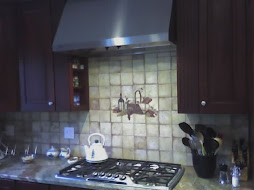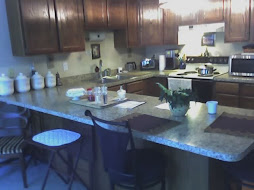
Our most recent weekend bathroom project transformed our hideous linoleum floor into a beautiful ceramic tile finish. With hours of help from my two handy sons, this chore started on Saturday and wrapped up Sunday afternoon. Good thing, too, since it's our only bathroom!
Bathroom floors take constant abuse from water, bare feet, and heavy traffic in general. Our original floor had gotten so ugly, and was so difficult to clean, that we generally closed our eyes on entering. In addition, the wood baseboard and shoe molding needed complete refinishing. I'm not sure what we could have done about the creepy smeared caulk around the perimeter. (Previous owner)
So what did we do about our icky floor? My youngest ripped out all the wood trim, and the three of us re-nailed the whole floor -- right through the old vinyl floor. We might have chosen to strip out all the existing floor materials down to the sub-floor, but that would've added another full day to the job. Since I'm the only one who has to guaranty this new installation, we cheated a bit. (Adding 1/2" DuRock or similar tile backer is a safer choice.)
The new tile we chose is very heavy, and imitates a weathered sandstone. Nice grip, and a dramatic three-dimensional look. Our new theme is "beach cottage" so this works perfectly. While it will be more difficult to clean than a smoother, shinier tile it adds enough character to the room to offset that concern.
We decided to use narrow (1/8") grout lines to emphasize the tile over the pattern, and to reduce the amount of exposed grout area. Grout stains much more easily than does tile, because it's so porous. We'll apply a sealer, but that's not a cure-all. The result, as you can see, is a floor that looks very much like an exposed sandstone shelf like you might find in a river or at a beach. Perfect!
copyright 2008 - all rights reserved
_______________________________________________
What's your opinion -- did we make a good decision? Do you think that a textured ceramic tile makes sense for a bathroom floor? Have a look at what we did to refinish our oak plank dining room floor for comparison.
Bathroom floors take constant abuse from water, bare feet, and heavy traffic in general. Our original floor had gotten so ugly, and was so difficult to clean, that we generally closed our eyes on entering. In addition, the wood baseboard and shoe molding needed complete refinishing. I'm not sure what we could have done about the creepy smeared caulk around the perimeter. (Previous owner)
So what did we do about our icky floor? My youngest ripped out all the wood trim, and the three of us re-nailed the whole floor -- right through the old vinyl floor. We might have chosen to strip out all the existing floor materials down to the sub-floor, but that would've added another full day to the job. Since I'm the only one who has to guaranty this new installation, we cheated a bit. (Adding 1/2" DuRock or similar tile backer is a safer choice.)
The new tile we chose is very heavy, and imitates a weathered sandstone. Nice grip, and a dramatic three-dimensional look. Our new theme is "beach cottage" so this works perfectly. While it will be more difficult to clean than a smoother, shinier tile it adds enough character to the room to offset that concern.
We decided to use narrow (1/8") grout lines to emphasize the tile over the pattern, and to reduce the amount of exposed grout area. Grout stains much more easily than does tile, because it's so porous. We'll apply a sealer, but that's not a cure-all. The result, as you can see, is a floor that looks very much like an exposed sandstone shelf like you might find in a river or at a beach. Perfect!
copyright 2008 - all rights reserved
_______________________________________________
What's your opinion -- did we make a good decision? Do you think that a textured ceramic tile makes sense for a bathroom floor? Have a look at what we did to refinish our oak plank dining room floor for comparison.
+edit.jpg)

.JPG)

+edit.jpg)
.JPG+edit.jpg)










.jpg)


